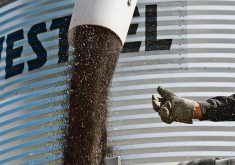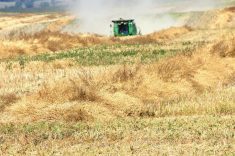A dry early fall on much of the Prairies has given way to a snowy and cold winter with signs the persistent La Nina weather pattern is finally breaking up, according to meteorologist Matt Makens.
“Overall, we’re looking at a neutrality pattern. (There will) be pockets of good water here and there, pockets of drought here and there, but, overall neutral,” said Makens of the seasonal outlook for the rest of winter and early spring.
The current snowpack is good and more precipitation is anticipated, he added.
Read Also

Farm Credit Canada partners with major Toronto innovation hub
A FCC parntership with MaRS Discovery District aims to solve technology problems in food supply chains.
“The most optimistic area of precipitation for me is out west, snow on the mountains, and I think the Rockies will pick up a fair amount of snowfall between now and spring,” said Makens.
January on the western Prairies will likely see higher than usual temperatures but pockets of cold air are developing in the north, which will result in cooler temperatures returning by the end of the month, continuing through February and March.
“I don’t know that the warm-up will be near enough to melt anything for central or eastern Prairies,” said Maken. “Bottom line, I think we’re going to keep that snowpack for the vast majority of us.”
This winter is influenced by a rare, third-straight La Nina event, but Maken said it is expected to weaken.
“We’re looking at a springtime transition away from La Nina and we may be hitting not just neutral but we may see the introduction of El Nino by summer or fall.”
That could result in a milder fall and winter with more precipitation if the prediction of a return of the traditional heavy spring rainfall the following year comes to fruition.
As for conditions on the Prairies this spring, Makens anticipates average precipitation overall.
“As you get into southern Manitoba, they may have a surplus of water, kind of like last year,” said Maken. “But everywhere else, pretty much neutral, and that’s better than where we were at last year because last year going into the spring, it was looking very, very dry.”
As for areas along the central part of the Alberta-Saskatchewan border that have seen persistent dry conditions, Maken said it’ll take a lot of precipitation for a break in those conditions.
“It’s going to take a lot of water, a lot of snowmelt in the snowpack to recover from that drought in those areas,” he said.
As for the western United States and its persistent drought, the recent atmospheric river earlier this month will help but not necessarily provide long-term relief.
“The drought numbers have improved for not just California, where that main flow of water has been falling, but throughout the Rocky Mountain region, western U.S.,” said Maken. “We’re not going to get rid of the drought in these areas overall but we have seen a rapid improvement.”
















